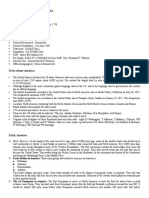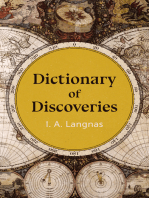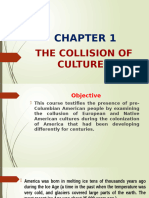Colonization in The New Continent
Colonization in The New Continent
Uploaded by
semp mardanCopyright:
Available Formats
Colonization in The New Continent
Colonization in The New Continent
Uploaded by
semp mardanOriginal Description:
Original Title
Copyright
Available Formats
Share this document
Did you find this document useful?
Is this content inappropriate?
Copyright:
Available Formats
Colonization in The New Continent
Colonization in The New Continent
Uploaded by
semp mardanCopyright:
Available Formats
Colonization in the New Continent
The first permanent European settlement in what was to become the United States was established by
the Spanish in the middle 1500s at St. Augustine in Florida. However, it would not play a part in the
formation of the new nation. That story took place in settlements farther north along the Atlantic coast
in Virginia, Massachusetts, New York, and the 10 other areas colonized by a growing tide of immigrants
from Europe.
Treaty of Tordesillas
Columbus returned from his first voyage, they persuaded Pope Alexander VI to issue an edict giving
Spain all lands west of an imaginary line through the Atlantic. Portugal was not satisfied. Through the
Treaty of Tordesillas (1494), the two countries agreed to move the line further west and give Portugal
exclusive right to the territory to the east. Although the result of the shift was unknown at the time, the
change put the eastern quarter of South America (Brazil) in the Portuguese sphere.
Colonial Period
Most settlers who came to the British colonies in the 1600s were English. Others came from The
Netherlands, Sweden, Germany, France, and later from Scotland and Northern Ireland. Some left their
homelands to escape war, political oppression, religious persecution, or a prison sentence. Some left as
servants who expected to work their way to freedom. Black Africans were sold into slavery and arrived
in shackles.
By 1690, the population was 250,000. Less than 100 years later, it had climbed to 2.5 million. The
settlers had many different reasons for coming to America, and eventually 13 distinct colonies
developed here. Differences among the three regional groupings of colonies were even more marked.
Causes of Colonization
1. Improvement in Technology: In Europe, there occurred a rebirth of classical learning. Columbus
and other navigators lived in the time when the creativity was vitally at the peak and navigator
and mariners were being financed to find out the shortest and safest routes to Asia. Europeans
were improving in technology from gun powder to the sailing compass. There were also major
improvements in ship building and map makings.
2. Renaissance in Europe: 1400 AD onwards is considered that to be the rising time of Europeans
after the Dark Age which was 200 to 1200 AD. The Europeans now were making progress in
every field of life and were keenly involve in learning and exploring. The technology of printing
press after 1450 also spread the knowledge across Europe which played a very important role in
educating the common man in Europe.
3. Religious Conflicts in Europe: The later years of renaissance were a time of religious zeal and
conflict in Europe. The dominant Roman Catholic culture was threatened by Othman empire
while the 35 37 Protestants revolted against the popeës authorities in Rome led to a series of
war between Protestants and Catholic Christians. The reforms by Protestants were known as
Protestants Reformation.
4. Expanding trade: Roots to Asia were blocked after Othman had taken over the city of
Constantinople in 1453. Europe were dependant on Asian for trade, herbs and agriculture
therefore they were in extensive need to find any other route to Asia.
You might also like
- American Colonies: The Settling of North America by Alan TaylorDocument9 pagesAmerican Colonies: The Settling of North America by Alan TaylorAnnisa RasyidahNo ratings yet
- Test Bank For Exploring American Histories, (Volume 1 +2), 4e Nancy Hewitt, Steven Lawson Test BankDocument19 pagesTest Bank For Exploring American Histories, (Volume 1 +2), 4e Nancy Hewitt, Steven Lawson Test BankNail BaskoNo ratings yet
- Tratado Sobre Esclavitud - A. SandovalDocument242 pagesTratado Sobre Esclavitud - A. SandovalCamila Amaral Ribeiro100% (2)
- Chapter 2 - The American Colonies EmergeDocument23 pagesChapter 2 - The American Colonies Emergeapi-233545455No ratings yet
- Unit 1 Objectives Student QuestionsDocument4 pagesUnit 1 Objectives Student Questionscrainwater101No ratings yet
- Ultramarine TravelDocument21 pagesUltramarine TravelScribdTranslationsNo ratings yet
- Protestantism Was Eform Grow Grievances and of M ,: The Portuguese Chart The CourseDocument3 pagesProtestantism Was Eform Grow Grievances and of M ,: The Portuguese Chart The CourseBerk AlbakerNo ratings yet
- American RevolutionDocument10 pagesAmerican RevolutionWaqar Ahmad BiyabaniNo ratings yet
- The Age of ExplorationDocument5 pagesThe Age of ExplorationMae Kimberly GomezNo ratings yet
- Colonization and ConquestDocument4 pagesColonization and ConquestEnzo CarterNo ratings yet
- Chapter 2 Summary Europeans Encounter The New World 1492 1600 PP 2753Document36 pagesChapter 2 Summary Europeans Encounter The New World 1492 1600 PP 2753sering15ukayNo ratings yet
- Test Bank For The Making of The West (Volume 2) 7e Lynn Hunt, Thomas Martin, Barbara Rosenwein, Bonnie Smith Test BankDocument11 pagesTest Bank For The Making of The West (Volume 2) 7e Lynn Hunt, Thomas Martin, Barbara Rosenwein, Bonnie Smith Test BankNail BaskoNo ratings yet
- Essay On Atlantic World Encounters: Shriyansh Tripathi Period - 8 DATE DUE-1/19/18 MR - CichonDocument6 pagesEssay On Atlantic World Encounters: Shriyansh Tripathi Period - 8 DATE DUE-1/19/18 MR - CichonAnonyms Ur Future BeginsNo ratings yet
- 5.2.1. Imperialism and Colonialism - Latin AmericaDocument9 pages5.2.1. Imperialism and Colonialism - Latin AmericaAbhishek ShivhareNo ratings yet
- Am Lit SP 24 ColumbusDocument39 pagesAm Lit SP 24 Columbus台師大高瑪麗No ratings yet
- AP World ReviewDocument10 pagesAP World ReviewChris GayleNo ratings yet
- Andrew Yang Period 7 Persian Chart AP World History Chapter 17: The West and The WorldDocument2 pagesAndrew Yang Period 7 Persian Chart AP World History Chapter 17: The West and The WorldapwhhchsNo ratings yet
- 14 An Outline of History of American LiteratureDocument47 pages14 An Outline of History of American LiteratureMalina CindeaNo ratings yet
- Caribbean Studies - Session 3Document26 pagesCaribbean Studies - Session 3Isaiah RojasNo ratings yet
- Economic and Political Motives: Factors That Motivated European Kingdoms To Explore The WorldDocument7 pagesEconomic and Political Motives: Factors That Motivated European Kingdoms To Explore The WorldHaru HaruNo ratings yet
- The Colonization of AmericaDocument6 pagesThe Colonization of AmericaLoretta Lynn AltmayerNo ratings yet
- Essay Outline 2Document3 pagesEssay Outline 2idzaanzulhazmieazNo ratings yet
- World HistoryDocument5 pagesWorld HistoryRobinsonLuis100% (1)
- Unit III Exam Study Guide - AP World HistoryDocument8 pagesUnit III Exam Study Guide - AP World HistoryShane TangNo ratings yet
- Chapter Two: When Worlds Collide, 1492-1590Document31 pagesChapter Two: When Worlds Collide, 1492-1590api-171412573100% (1)
- Colonial Expansion 1Document9 pagesColonial Expansion 1opakulsriruenNo ratings yet
- Civ Amer L1 2022Document8 pagesCiv Amer L1 2022Oothentiik NGNo ratings yet
- History DbaDocument3 pagesHistory Dbabrianna torralbaNo ratings yet
- What Is ColonialismDocument5 pagesWhat Is ColonialismWasima Tabassum100% (1)
- Age of ExplorationDocument6 pagesAge of ExplorationEric James AbarroNo ratings yet
- Lect. 2.1 Historical ProcessDocument12 pagesLect. 2.1 Historical Processakeyahdore10No ratings yet
- First Global AgeDocument12 pagesFirst Global Ageapi-235209117100% (2)
- Puritans, Part IDocument89 pagesPuritans, Part Inecca0070% (1)
- European Colonization of The AmericasDocument3 pagesEuropean Colonization of The AmericasAlmira ĆosićNo ratings yet
- Persian Ay - 15Document3 pagesPersian Ay - 15apwhhchsNo ratings yet
- WHII.4 Age of Exploration NarrativeDocument4 pagesWHII.4 Age of Exploration Narrativeniabae15No ratings yet
- REVIEWERDocument11 pagesREVIEWERjuan.marquez722726No ratings yet
- E E I D N A: Vents AND Conomics Nfluencing THE Evelopment OF Orth MericaDocument7 pagesE E I D N A: Vents AND Conomics Nfluencing THE Evelopment OF Orth Mericawinter0011No ratings yet
- Topic: Age of Exploration and Its ImpactDocument13 pagesTopic: Age of Exploration and Its ImpactSakib MhmudNo ratings yet
- Out of Many: Chapter 2Document46 pagesOut of Many: Chapter 2Marcos ShepardNo ratings yet
- Notes - History of USADocument32 pagesNotes - History of USAsobiaNo ratings yet
- Trans Atlantic Slave TradeDocument4 pagesTrans Atlantic Slave Trademodouljagne5No ratings yet
- Disovering of America: Yevheniia Andruschenko 34FrDocument20 pagesDisovering of America: Yevheniia Andruschenko 34FrЄвгенія АндрущенкоNo ratings yet
- People and Their Contexts: A Chronology of the 16Th Century WorldFrom EverandPeople and Their Contexts: A Chronology of the 16Th Century WorldNo ratings yet
- Age of Exploration and Trade PPDocument25 pagesAge of Exploration and Trade PPbtcherryNo ratings yet
- 15th Century EuropeansDocument10 pages15th Century EuropeansMelissa AlexanderNo ratings yet
- Euroepean HistoryDocument37 pagesEuroepean HistorylaparauranNo ratings yet
- USA Upto Constitution Making IssuesDocument16 pagesUSA Upto Constitution Making IssuesAfaq AlamNo ratings yet
- Tema 2 - THE COLONIAL PERIODDocument13 pagesTema 2 - THE COLONIAL PERIODTeresa MartínNo ratings yet
- Colonial Expansion and The Columbian Exchange (AP Euro AMSCO Notes)Document7 pagesColonial Expansion and The Columbian Exchange (AP Euro AMSCO Notes)MagmaFang StudiosNo ratings yet
- History of Colonialism - WikipediaDocument30 pagesHistory of Colonialism - WikipediaolufemieniolasarahNo ratings yet
- Major Aspects of European Society in The Late 15th CenturyDocument8 pagesMajor Aspects of European Society in The Late 15th CenturysaphNo ratings yet
- Chapter 1 The Collision of CulturesDocument18 pagesChapter 1 The Collision of CulturesMariaOceanne076No ratings yet
- Columbian Voyages and ExchangeDocument8 pagesColumbian Voyages and ExchangeEngr KhaleeqNo ratings yet
- HIST108 The Advent of ColonialismDocument2 pagesHIST108 The Advent of ColonialismrosieNo ratings yet
- MessageDocument44 pagesMessagegordonpshNo ratings yet
- The Columbian Exchange PowerpointDocument17 pagesThe Columbian Exchange Powerpointapi-534868671No ratings yet
- The Enduring Vision, Vol. 1: Boyer - Chapter 2 OutlineDocument7 pagesThe Enduring Vision, Vol. 1: Boyer - Chapter 2 OutlineAshley AdamsNo ratings yet
- Second Quiz Gen 004 Coverage Day 7 10Document14 pagesSecond Quiz Gen 004 Coverage Day 7 10Morikidan YukizutoNo ratings yet
- Answer:: Flow of GoodsDocument6 pagesAnswer:: Flow of Goodsvihaanm949No ratings yet
- Age of European Exploration and Conquest APADocument5 pagesAge of European Exploration and Conquest APAChris BrianNo ratings yet
- The Trans Atlantic Slave Trade DBQ Parts For Group ActivityDocument9 pagesThe Trans Atlantic Slave Trade DBQ Parts For Group ActivityDerius PoliteNo ratings yet
- Spanish Slavery in The PhilippinesDocument2 pagesSpanish Slavery in The PhilippinesMaylin OmpadNo ratings yet
- United States of AmericaDocument11 pagesUnited States of AmericaItsDomNo ratings yet
- AP ReviewerDocument3 pagesAP ReviewerSheryl Ann De los ReyesNo ratings yet
- Latin America Mapping Lab TEXTDocument9 pagesLatin America Mapping Lab TEXTIbukun OlusogaNo ratings yet
- Spain Builds An American Empire LessonDocument3 pagesSpain Builds An American Empire Lessonira.arandaNo ratings yet
- Cristobal Colon PDFDocument2 pagesCristobal Colon PDFmarjorielunaNo ratings yet
- 3rd Social Studies Cobb Teaching Learning FrameworkDocument3 pages3rd Social Studies Cobb Teaching Learning Frameworkapi-344279522No ratings yet
- Columbian ExchangeDocument3 pagesColumbian Exchangezahra.khumriNo ratings yet
- MAS 141 - 07 HW No C CualDocument2 pagesMAS 141 - 07 HW No C Cualvanessa solanoNo ratings yet
- PERIOD 3: 1754-1800: Advanced Placement and AP Are Registered Trademarks of The College BoardDocument1 pagePERIOD 3: 1754-1800: Advanced Placement and AP Are Registered Trademarks of The College BoardkatliynperoNo ratings yet
- History Sba ResearchDocument4 pagesHistory Sba ResearchKerissa Kissoon100% (1)
- GEN 004 Prelims ReviewerDocument14 pagesGEN 004 Prelims ReviewerKent Juguilon100% (1)
- Unit 2 ReviewDocument20 pagesUnit 2 ReviewFelipe MedradoNo ratings yet
- The APUSH (Er)Document93 pagesThe APUSH (Er)TorukNo ratings yet
- Test Bank For A People and A Nation Volume I To 1877 11th Edition by KamenskyDocument16 pagesTest Bank For A People and A Nation Volume I To 1877 11th Edition by KamenskyAndres Villa100% (7)
- BrainPOP Christopher Columbus QuizDocument1 pageBrainPOP Christopher Columbus Quiz190794No ratings yet
- Engleza Cls A 9 A A Var 2023Document4 pagesEngleza Cls A 9 A A Var 2023Luca GeorgeNo ratings yet
- Conquest of The AmericasDocument118 pagesConquest of The AmericasAnondotcom100% (1)
- Chapter 2 Summary Europeans Encounter The New World 1492 1600 PP 2753Document36 pagesChapter 2 Summary Europeans Encounter The New World 1492 1600 PP 2753sering15ukayNo ratings yet
- Eighteenth-Century Art WorldsDocument486 pagesEighteenth-Century Art WorldsKunya liaNo ratings yet
- WHP 5-4-2 Read - The Transatlantic Slave Trade - 1200LDocument7 pagesWHP 5-4-2 Read - The Transatlantic Slave Trade - 1200LLucas ParkNo ratings yet
- Metacom Biography, War, & FactsDocument1 pageMetacom Biography, War, & Factsfbg gbNo ratings yet
- LocHist Midterm Module MergedDocument52 pagesLocHist Midterm Module MergedanzuresshanahNo ratings yet
- Colonial Times - Highlights: Travel and TransportationDocument2 pagesColonial Times - Highlights: Travel and TransportationniknjenNo ratings yet
- EmmaDocument50 pagesEmmaNtiamoah EmmanuelNo ratings yet
- Eff Reading MaterialDocument59 pagesEff Reading MaterialInnocent NsibandeNo ratings yet
























































































